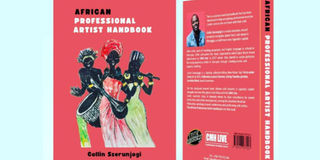Prime
New book lays out how an artist can hit a target

What you need to know:
History. It is particularly illuminating, especially the part on being true to oneself. The author insists that authenticity should be the axle upon which your brand turns.
Okay, let’s paint a scenario. You visit the British Council in Kampala to attend a Masterclass for performing artists and you take your seat. Surreptitiously, you look around to see if you recognise anyone in the class. Nope. Nobody looks familiar.
While you are thinking about how you are going to introduce yourself to a number of strangers, the course facilitator tasks the whole class to write down three words that describe who they are. Suddenly, you find that the question “Who am I?” leads to a mine-strewn field of many subsidiary questions such as where do I come from? What are my real desires? And what are my true fears and dreams?
This vignette best describes what music educator, record producer and guitarist Cole Sserunjogi went through and serves as the matrix from which his book “African Professional Artist Handbook” sprang into cold print with warmed over enthusiasm. It is a practical working handbook that has been written to nurture budding as well as seasoned talents so they can take their craft to the next level.
Primarily, it is for the “artist-musician” but contains lessons for poets, comedians and any number of performing artists. Basically, anyone who hopes to parlay talent or passion into a skill that will develop their professional career as well as teachers of the performing arts working at varying levels of the education pyramid, as it were.
Structured around modules, it will give you plenty to ponder. Module One, Personality Identity, goes back to the question: “Who I am?” The distinguishing personality dimensions which issue from an honest answer about who you are will influence your creativity.
The author found out that his love of people actuated his passion for organising public events and seeing people happy. This shows how his personality identity played to his activities like a puppet on a string.
Module Two, Your Craft Identity, speaks to craft development lending itself to a number of channels; chief of which is a content strategy.
“By committing time to the early stages of developing a content strategy with research, you can make sure all the work you put into content marketing is targeted at the right audience, address the things you and your audience care about and will help you achieve the specific goals you want to get from others,” the author writes.
It is important to define your audience. Standup comedian Daniel Omara used to perform in front of audiences that did not get his brand of observational humour and satire. His jokes would thus fall flat in the face of audiences that preferred slapstick to wit. When he realised that he could demassify his audience by winnowing who to perform for and who not to in view of what his target audience was and who was not, he started getting plenty more laughs.
Module Three, Tools, explores the specific means by which an artist may achieve their goals. Here, Training/Education, assembling a portfolio, joining an association and gaining work experience are fundamentals of what an artist needs to achieve.
On the subject of gaining experience in order to have something to put in your Electronic Press Kit, you might have to sometimes work for free if nobody is hiring. The point is to work. This applies to writers, too. Jeff Goins, the writer, keynote speaker, and entrepreneur with a reputation for challenging the status quo, once stated:
“Spending five hours on a Saturday writing isn’t nearly as valuable as spending 30 minutes a day every day of the week. Especially when you’re just getting started. The idea is repetition — developing a discipline of showing up, making this a priority, and working through The Resistance. If you want to get this writing thing down, you need to start writing every day. No questions asked, no exceptions made. After all, this isn’t a hobby we’re talking about; it’s a discipline.”
Module Five, Brand and Packaging, is particularly illuminating, especially the part on being true to oneself by being real. The author insists that authenticity should be the axle upon which your brand turns since it distinguishes you from the next person.
“Be ready to show who you are, what you stand for, your passions, and stay true to your sound,” he exhorts.
It is important to know who you are and express it, but in a dynamic world, he adds, you must appreciate that your brand changes over time. This might require reinvention, even going on a spiritual journey within.
Book Title: African Professional Artist Handbook
Author: Collin Sserunjogi
Year of Publication: 2024
Pages: 77
Price: Shs30,000
Where: Nzani Creative Hub




